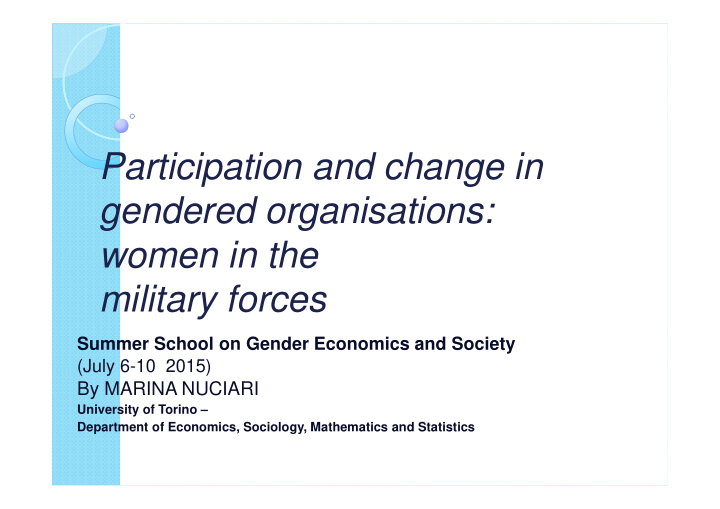



Participation and change in gendered organisations: women in the military forces Summer School on Gender Economics and Society (July 6-10 2015) By MARINA NUCIARI University of Torino – Department of Economics, Sociology, Mathematics and Statistics
WHAT ARE WE SPEAKING ABOUT? Occupations are generally linked to gender stereotypes defining feminine as well as masculine jobs, as research on women and men in nontraditional or unconventional occupations has largely demonstrated. This is especially true for military and defense/security jobs. This is why military organisations are normally considered as gendered organisations. Womensoldiers recruitment and career within armed forces have inevitably produced various reactions and adaptations, both on military organisations themselves and women approach to them, as far as military roles are considered (working places or something “more than just a job”). Discussion is based on recent comparative research on womensoldiers condition in armed forces with special reference to NATO countries.
UNSCR 1325 The participation of women in Allied armed forces has been steadily increasing over the past few decades, and significant strides have been made towards the recruitment and retention of women. However, women continue to be underrepresented and more work is needed to implement United Nations Security Council Resolution (UNSCR) 1325 and related Resolutions on Women, Peace and Security.
Reasons to increase women participation in military forces (UNSCR 1325 Reload) Significant cultural change has been achieved in recent years through new policies and reforms based on the following key principles outlined in UNSCR 1325 Reload. Can be taken as recommendations for best practices: 1) Strong leadership drives reform; 2) Diversity of leadership increases capability; 3) Increasing numbers requires increasing opportunities; 4) Greater flexibility will strengthen the ADF; 5) Gender-based harassment and violence ruins lives, divides teams and damages operational effectiveness.
A long story: reasons to join Factors affecting women’s military participation (M. W. Segal, 1995) Military factors Social structure Culture Socio-political issues (internal and external pressure) Policies
MILITARY VARIABLES Military variables are considered in a wide sense, and include national security situation, kind and level of military technology, the combat to support function ratio, the structure of forces and the policies driving accession to the military.
SOCIAL STRUCTURE Social structure variables include country’s demographic pattern, characteristics of the labour force (women’s participation to the labour force and occupational gender segregation), the state of civilian economy (expansion or depression), the structure of the family (average age of marriage and maternity, role responsibilities sharing).
CULTURE Cultural variables such as the social construction of the notions of gender and family, social values underlining the above definitions, public discourse about gender and gender equality, values concerning the ascriptive definition of social roles and the question of equity.
POLICIES Diversity politics Current policy issues Interest groupings: various women’s networks in different countries
INTERNATIONAL VARIABLES External pressures Being part of a Treaty or an Alliance Participating in International Operations Participating in Crises Response Operations or MOOTWs
The cultural dimension It appears to be crucial It is always at the background and beside every change in the other two dimensions (military and social structure) Cultural change: the social construction of gender (femininity and masculinity) is culturally determined, it changes according to time and cultural variety.
Civilianisation The process of civialianisation (M. Janowitz, 1960): ◦ Technical roles are similarly structured in the military and in big corporations ◦ Growing beaurocratic and managerial role-content ◦ Prolonged peace removes the perception of military practice as a combat practice
Consequences on women acceptance in military institutions Women are accepted in parallel roles within civilian societies Usually the highest proportion of female personnel in military forces is in the Air Force, where technical roles outnumber combat roles and where voluntary recruitment is higher even where compulsory military service is the dominant pattern.
Which roles for women in the military forces? Administrative sectors Technical and logistic services Combat-support technical roles Combat roles are the last to be permitted Entry is allowed firstly for medium and medium-high ranks (officers and NCOs) and as a second steps for private soldiers.
Roles main features Civilianlike roles (the least true military roles) cab be easily filled with women because of the growing availability of young women with medium and high education standards. Technical and administrative roles have an intrinsic lower combat content, that is they are in any case peripheral roles.
THE GENDERED ORGANISATION The concept of «token» (R. Kanter, 1977) ◦ Tokenism is a condition in which ◦ women working in a male-dominated environment find themselves ◦ when their relative number is very small Four components: ◦ Pressures toward performance ◦ Social isolation ◦ Role entrapment ◦ Boundary heightening
THE GENDERED ROLE SET All this tends to exclude women from the dominant group, as it is the case for women in managerial positions who are not accepted as «colleagues» by male managers. Such a situation is dependent on gender ratio in the teamwork.
FOUR TYPES of GROUPS UNIFORM GROUP (100:0 ratio, an all-male or all-female group) SKEWED GROUP (85:15 ratio, dominant versus token culture) TILTED GROUP (65:35 ratio, strong minorities affect majority culture) BALANCED GROUP (60:40 ratio, culture balance).
FOUR-CAREER TYPOLOGY (K. Dunivin, 1988) TRADITIONAL NONTRADITIONAL less positive attitude Similar attitudes for men and underestimated job women token peception High evaluation given to job traditional job Status matters more than gender FEW WOMEN more positive attitude many women in low power and nontraditional job autonomy given to traditional job THIS WOULD BE THE REAL low prestige job CHANGE perception MANY WOMEN
ANY DOUBT ANY QUESTION ? THANK YOU FOR YOUR ATTENTION !
Recommend
More recommend